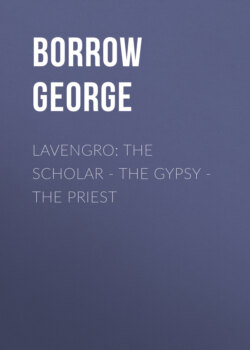Читать книгу Lavengro: the Scholar - the Gypsy - the Priest - Borrow George - Страница 5
На сайте Литреса книга снята с продажи.
III. Isopel Berners.
ОглавлениеTable of Contents
For instance, the tall girl, Isopel Berners—the most vigorous sketch he has given us—is perfect as she is adorable. Among heroines she stands quite alone; there is none other that is in the least like her. Yet she is in many of her qualities typical of a class. Among the very bravest of all human beings in the British Islands are, or were, the nomadic girls of the high road and the dingle. Their bravery is not only an inherited quality: it is in every way fostered by their mode of life. No tenderness from the men with whom they travel, either as wives or as mistresses, do they get—none of the chivalry which girls in most other grades of life experience—and none do they expect. In all disputes between themselves and the men, their associates, they know that the final argument is the knock-down blow. With the Romany girl, too, this is the case, to be sure; but then, while the Romany girl, as a rule, owing to tribal customs, receives the blow in patience, the English girl is apt to return it, and with vigour. This condition of things gives the English road-girl a frank independence of bearing which distinguishes her from girls of all other classes. There is something of the charm of the savage about her, even to her odd passion for tattoo. No doubt Isopel is an idealisation of the class; but the class, with all its drawbacks, has a certain winsomeness for men of Borrow’s temperament.
But, unfortunately, his love of the wonderful, his instinct for exaggeration, asserts itself even here. I need give only one instance of what I mean. He makes Isopel Berners speak of herself as being taller than Lavengro. Now, as Borrow gives Lavengro his own character and physique in every detail, even to the silvery hair and even to the somewhat peculiar method of sparring, and as he himself stood six feet two inches, Isopel must have been better adapted to shine as a giantess in a show than as a fighting woman capable of cowing the “Flaming Tinman” himself.
It is a very exceptional woman that can really stand up against a trained boxer, and it is, I believe, or used to be, an axiom among the nomads that no fighting woman ought to stand more than about five feet ten inches at the outside. A handsome young woman never looks so superb as when boxing; but it is under peculiar disadvantages that she spars with a man, inasmuch as she has, even when properly padded (as assuredly every woman ought to be) to guard her chest with even more care than she guards her face. The truth is, as Borrow must have known, that women, in order to stand a chance against men, must rely upon some special and surprising method of attack—such, for instance, as that of the sudden “left-hand body blow” of the magnificent gypsy girl of whose exploits I told him that day at “Gypsy Ring”—who, when travelling in England, was attached to Boswell’s boxing-booth, and was always accompanied by a favourite bantam cock, ornamented with a gold ring in each wattle, and trained to clap his wings and crow whenever he saw his mistress putting on the gloves—the most beautiful girl, gypsy or other, that ever went into East Anglia. This “left-hand body blow” of hers she delivered so unexpectedly, and with such an engine-like velocity, that but few boxers could “stop it.”
But, with regard to Isopel Berners, neither Lavengro, nor the man she thrashed when he stole one of her flaxen hairs to conjure with, gives the reader the faintest idea of Isopel’s method of attack or defence, and we have to take her prowess on trust.
In a word, Borrow was content to give us the Wonderful, without taking that trouble to find for it a logical basis which a literary master would have taken. And instances might easily be multiplied of this exaggeration of Borrow’s, which is apt to lend a sense of unreality to some of the most picturesque pages of “Lavengro.”
